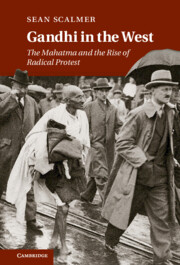6 - An idea whose time has come?
Published online by Cambridge University Press: 03 May 2011
Summary
‘An Idea Whose Time Has Come’, so intoned Gandhi's most influential translator, Richard Gregg. It was April 1962, and he referenced the power of non-violence. Gregg's memory extended to the false prophecies of the 1930s and the timid experiments of mid-century. But by now he could also survey nearly a decade of unprecedented activism.
From the mid-1950s, movements for civil rights and against nuclear arms perfected satyagraha as a form of mass politics for the West. The landmarks loom large, still half a century later. In Britain, the campaign to ‘ban the bomb’ encompassed invasions of rocket sites from 1958 and ‘sit-down’ demonstrations in central London from 1961. At Easter time, a year before Gregg's commentary, 150,000 people joined the fifty-two-mile march from the Aldermaston reactor to the national capital; later that September, 1,300 were arrested in a knowingly illegal demonstration underneath Horatio Nelson's stony gaze, in Trafalgar Square. Alex Comfort's tuneful incitement, ‘Sit, Brothers, Sit’, captured the developing sensibility with perceptive whimsy:
Then sit, brothers, sit,
And let every brother sit,
The bombs and bases to picket:
While you've still got an arse you can say they shall not pass.
Sit down and the cops can't kick it.
In the United States, the movement for African-American civil rights mobilised earlier and ranged even further. A boycott of segregated buses in Montgomery, Alabama began in December 1955, when 50,000 residents united under the leadership of a young pastor, a certain Dr Martin Luther King Jr. From February 1960, a ‘sit-in’ movement spread from Greensboro, North Carolina.
- Type
- Chapter
- Information
- Gandhi in the WestThe Mahatma and the Rise of Radical Protest, pp. 167 - 205Publisher: Cambridge University PressPrint publication year: 2011

